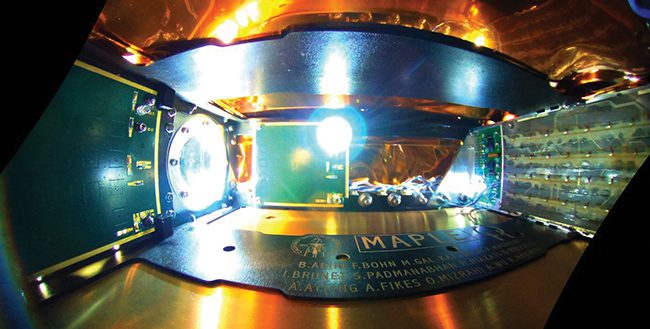Space Solar Power Prototype Beams First Power to Earth
California Institute of Technology’s (Caltech’s) first space-borne prototype launched into orbit has demonstrated the ability to wirelessly transmit power in space and beam detectable power to Earth. The achievement marks a significant leap for space-based solar power, concepts that seek to harvest solar power in space and then beam it down to Earth via microwave radiation, potentially for grid consumption. Though often dismissed as far-fetched, space-based solar power has been quietly making remarkable progress, and it has garnered international interest for its potential to tap into the unlimited supply of solar energy in outer space.
Caltech’s Space Solar Power Demonstrator (SSPD-1), which launched into orbit in early January, is a 50-kilogram prototype comprising three main technologies. The milestone announced in June was demonstrated by MAPLE (Microwave Array for Power-transfer Low-orbit Experiment), an array of flexible, lightweight microwave power transmitters aboard the SSPD-1. Driven by custom electronic chips (built using low-cost silicon technologies), MAPLE’s transmitters use “precise timing-control elements to dynamically focus the power selectively on the desired location using the coherent addition of electromagnetic waves,” the research institute explained. MAPLE has been slated for a series of experiments, from an initial function verification to an evaluation of the performance of the system under different environments over time.”
“Through the experiments we have run so far, we received confirmation that MAPLE can transmit power successfully to receivers in space,” said Ali Hajimiri, a Bren Professor of Electrical Engineering and Medical Engineering (and co-director of the Space-based Solar Power Project [SSPP]) who developed MAPLE. “We have also been able to program the array to direct its energy toward Earth, which we detected here at Caltech. We had, of course, tested it on Earth, but now we know that it can survive the trip to space and operate there.”
 |
|
This photo from space shows the interior of MAPLE, with its transmission array to the right and the receivers to the left. Courtesy: California Institute of Technology/Space Solar Power Project |
A Big Feat: Wireless Energy Transfer
Caltech noted that MAPLE features two separate receiver arrays about a foot from the transmitter. The receivers “convert it to direct current (DC) electricity and use it to light up a pair of LEDs to demonstrate the full sequence of wireless energy transmission at a distance in space,” it said. “MAPLE tested this in space by lighting up each LED individually and shifting back and forth between them.”
According to Hajimiri, the feat is pioneering. “To the best of our knowledge, no one has ever demonstrated wireless energy transfer in space even with expensive rigid structures,” he said. “We are doing it with flexible, lightweight structures and with our own integrated circuits. This is a first,” he said.
More remarkably, MAPLE also includes a “small window” through which the array can beam the energy. “This transmitted energy was detected by a receiver on the roof of the Gordon and Betty Moore Laboratory of Engineering on Caltech’s campus in Pasadena,” Caltech said. “The received signal appeared at the expected time and frequency, and had the right frequency shift as predicted based on its travel from orbit.”
The achievements have been monumental for Caltech. Just six months ago, on Jan. 3, 2023, the team celebrated the successful launch of the SSPD-1, which was carried by a Momentus Vigoride spacecraft aboard a SpaceX rocket on the Transporter-6 mission. That feat alone demonstrated that the power transmitters could survive the launch and space flight. “For SSPP to be feasible, energy transmission arrays will need to be lightweight to minimize the amount of fuel needed to send them to space, flexible so they can fold up into a package that can be transported in a rocket, and a low-cost technology overall,” the organization noted. In addition, the experiment is not sealed, “so it is subject to the harsh environment of space, including the wide temperature swings and solar radiation that will be faced one day by large-scale SSPP units,” it said.
Besides MAPLE, SSPD-1 is also testing DOLCE (Deployable on-Orbit ultraLight Composite Experiment)—a structure measuring 6 feet by 6 feet that demonstrates the architecture, packaging scheme, and deployment mechanisms of the modular spacecraft—and Alba, a collection of 32 different types of photovoltaic cells. Alba will allow researchers to assess the types of solar cells “that are the most effective in the punishing environment of space,” Caltech said. As of June 1, the Alba tests of solar cells were ongoing, though the SSPP had not yet attempted to deploy DOLCE. “Results from those experiments are expected in the coming months,” Caltech said.
—Sonal Patel is a POWER senior associate editor (@sonalcpatel, @POWERmagazine).